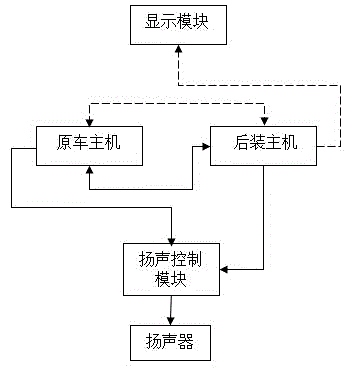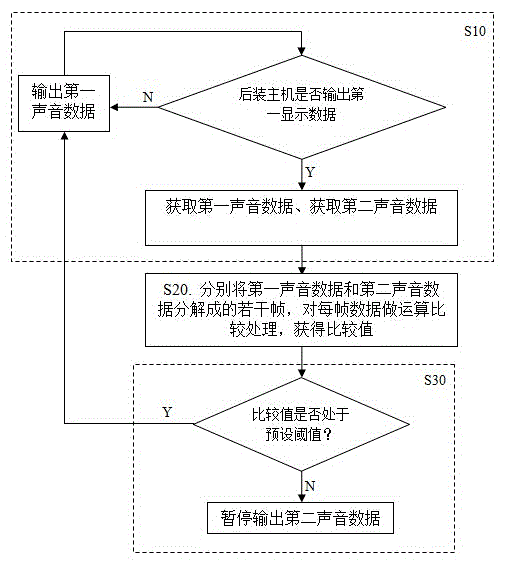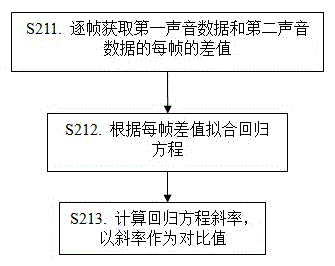Multi-output sound source recognition method and vehicle-mounted multi-sound-source system based on method
A recognition method and multi-sound source technology, applied to frequency/direction characteristic devices, etc., can solve problems such as poor user experience and sound source errors, and achieve the effects of improving system utilization, avoiding errors, and improving user experience
- Summary
- Abstract
- Description
- Claims
- Application Information
AI Technical Summary
Problems solved by technology
Method used
Image
Examples
Embodiment 1
[0043] Make a linear regression judgment on the difference between the first sound data and the second sound data, such as image 3 shown, including the following steps:
[0044] S211. Obtain the difference between the first sound data and the second sound data frame by frame, and obtain a total of n difference;
[0045]S212. Set the frame as the abscissa x , set the No. i frame x i , the difference between the first sound data and the second sound data is the ordinate y , No. i The frame-to-frame difference is y i , according to this n A straight line is fitted to the set of data, and according to the actual situation, it is simplified to a one-variable linear regression, which is the straight line equation y=kx+b.
[0046] S213. Calculate the slope of the unary linear regression equation , is the mean value of the abscissa, is the average value of the ordinate, and the slope is used as a comparison value.
[0047] If the first sound data output by the origin...
Embodiment 2
[0050] Judgment is made by calculating the variance eigenvalues of the first sound data and the second sound data respectively, such as Figure 4 shown, including the following steps:
[0051] S221. Align the first sound data in units of frames and second sound data Calculate the variance, get the variance of the first sound data , the variance of the second sound data
[0052] S222. Variance of the first sound data Variance with second sound data do subtraction;
[0053] S223. Obtain a variance difference value, and use the variance difference value as a comparison value.
[0054] Usually, if the first sound data output by the original car main unit is the same as the second sound data output by the after-installed main unit, the two variances should be the same, that is, the comparison value is 0. A threshold range with 0 as the center can be set within the error range. If the variance difference value is within the threshold range, continue to output the sec...
Embodiment 3
[0056] After normalizing the first sound data and the second sound data, make a frame-by-frame difference, and judge according to the difference, such as Figure 5 shown, including the following steps:
[0057] S231. Perform MIN-MAX normalization processing on the first sound data and the second sound data respectively: ,in: X* is the value after normalization; X is the value before normalization; min is the minimum value of the sampling data set; max is the maximum value of this sampling data set.
[0058] S232. Acquire the normalized first sound data frame by frame and second sound data difference ,in .
[0059] S233. The difference of each frame Add to get the difference and , and taking this difference and as a comparison value.
[0060] Normally, if the first sound data output by the original car head unit is the same as the second sound data output by the after-installed head unit, the difference between them per frame should be 0, the difference...
PUM
 Login to View More
Login to View More Abstract
Description
Claims
Application Information
 Login to View More
Login to View More - Generate Ideas
- Intellectual Property
- Life Sciences
- Materials
- Tech Scout
- Unparalleled Data Quality
- Higher Quality Content
- 60% Fewer Hallucinations
Browse by: Latest US Patents, China's latest patents, Technical Efficacy Thesaurus, Application Domain, Technology Topic, Popular Technical Reports.
© 2025 PatSnap. All rights reserved.Legal|Privacy policy|Modern Slavery Act Transparency Statement|Sitemap|About US| Contact US: help@patsnap.com



